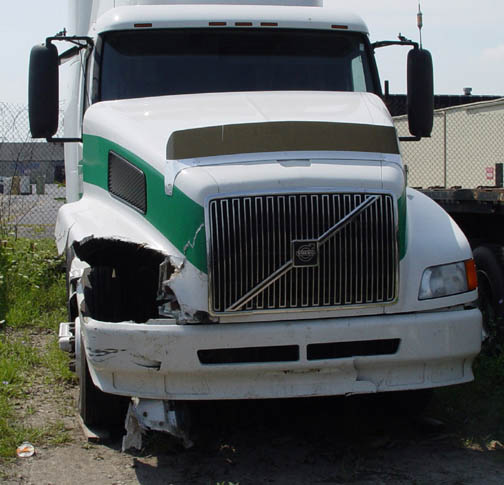
Figure 1

Figure 2
Inspection of the steering linkages revealed the steering
arm of Figure 2 with a failed ball joint that was no longer
connected to the drag link (a bar connected to the steering
gear that turns the wheels right or left.) Figure 3 is a close-
up of the ball joint showing a pitted and corroded surface of
the ball joint (arrow).

Figure 3

Figure 4
Figure 4 shows the other end of the ball joint that was attached to the drag link. Examination of the joint suggests
that lack of lubrication caused the failure. The joint is a
sealed joint and does not have a grease fitting. With over
360,000 miles on the tractor, this failure is characteristic of
wear-out of the ball joint assembly. Over time, seals on
sealed units fail with loss of lubricant or contamination of
the lubricant. As friction increases in the ball joint, severe
wear takes place until the ball joint stud is not captured by
the socket, resulting in steering failure. Periodic vehicle inspections should discover worn joints. Also, a driver familiar with the vehicle should note sloppiness in the steering
while operating the vehicle. In this case, the insured performed the vehicle inspections obviating any chance of
subrogation.
FOR TECHNICAL ARTICLES CONTACT CLAIMS MAGAZINE AND ASK
FOR A REPRINT OF A PAST TECHNICAL NOTEBOOK ARTICLE
CLAIMS MAGAZINE
BACK TO C. ROBERTS CONSULTING ENGINEERS HOME PAGE,
WWW.CROBERTS.COM

Figure 2

Figure 3

Figure 4
Figure 4 shows the other end of the ball joint that was attached to the drag link. Examination of the joint suggests
that lack of lubrication caused the failure. The joint is a
sealed joint and does not have a grease fitting. With over
360,000 miles on the tractor, this failure is characteristic of
wear-out of the ball joint assembly. Over time, seals on
sealed units fail with loss of lubricant or contamination of
the lubricant. As friction increases in the ball joint, severe
wear takes place until the ball joint stud is not captured by
the socket, resulting in steering failure. Periodic vehicle inspections should discover worn joints. Also, a driver familiar with the vehicle should note sloppiness in the steering
while operating the vehicle. In this case, the insured performed the vehicle inspections obviating any chance of
subrogation.
FOR TECHNICAL ARTICLES CONTACT CLAIMS MAGAZINE AND ASK
FOR A REPRINT OF A PAST TECHNICAL NOTEBOOK ARTICLE
CLAIMS MAGAZINE
BACK TO C. ROBERTS CONSULTING ENGINEERS HOME PAGE,
WWW.CROBERTS.COM

Figure 4
FOR TECHNICAL ARTICLES CONTACT CLAIMS MAGAZINE AND ASK
FOR A REPRINT OF A PAST TECHNICAL NOTEBOOK ARTICLE
CLAIMS MAGAZINE
BACK TO C. ROBERTS CONSULTING ENGINEERS HOME PAGE,
WWW.CROBERTS.COM
WWW.CROBERTS.COM